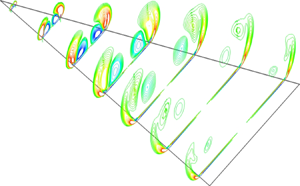Article contents
Vortex force maps for three-dimensional unsteady flows with application to a delta wing
Published online by Cambridge University Press: 13 August 2020
Abstract

The unsteady forces acting on a body depend strongly on the local flow structures such as vortices. A quantitative understanding of the contribution of these structures to the instantaneous overall force is of fundamental significance. In the present study, a three-dimensional (3-D) vortex force map (VFM) method, extended from a two-dimensional (2-D) one, is used to provide better insight into the complex 3-D flow dynamics. The VFM vectors are obtained from solutions of potential equations and used to build the 3-D VFMs where the critical regions and directions associated with significant positive or negative contributions to the forces are identified. Using the existing velocity/vorticity field near the body, these VFMs can be used to obtain the body forces. A decomposed form of the force formula is also derived to separate the correction term contributed from the uncaptured vortices (close to or far away from the body). The present method is applied to the starting flow of a delta wing at high angle of attack, where LEVs are enhanced and stabilized by an axial flow effect. The analogy between the normal force of a slender delta wing and that of a 2-D flat plate with a steadily growing span is demonstrated via the VFM analysis. We find, for this application, that the force evolution exhibits some similar behaviour to a 2-D airfoil starting flow and, surprisingly, the force contribution mainly comes from the conical vortex sheet rather than the central core. Moreover, a quantitative understanding of the influence of LEVs in different evolution regimes on the body force is demonstrated.
JFM classification
- Type
- JFM Papers
- Information
- Copyright
- © The Author(s), 2020. Published by Cambridge University Press
References
REFERENCES
- 15
- Cited by


